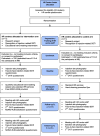A hand-washing community-based educational intervention to reduce abscess incidence among people who inject drugs: a cluster randomised controlled clinical trial protocol (the HAWA study protocol)
- PMID: 39420312
- PMCID: PMC11484296
- DOI: 10.1186/s12889-024-20299-x
A hand-washing community-based educational intervention to reduce abscess incidence among people who inject drugs: a cluster randomised controlled clinical trial protocol (the HAWA study protocol)
Abstract
Background: Besides the high prevalence of HIV and HCV infections, people who inject drugs (PWID) have a cumulative risk of acquiring skin and soft tissue infections (SSTI) from, among other things, social precariousness, homelessness/unstable housing, and unhygienic injecting practices. We propose to evaluate whether a two-component educational hand hygiene intervention which combines training in hand-washing with the supply of a single-use alcohol-based hand rub, called MONO-RUB, is effective in reducing injection-related abscesses in the PWID population. Specifically, we shall implement a nationwide, two-arm, multi-centre, cluster randomised controlled trial to evaluate the effectiveness and cost-effectiveness of this intervention in PWID.
Methods: HAWA is a community-based participatory research study to be conducted in 22 harm reduction centres (HR) in France (not yet recruiting); the latter will be randomised into two clusters: centres providing standard HR services and the intervention (i.e., intervention group) and those providing standard HR services only (i.e., control group). After randomization, each cluster will include 220 PWID, with an inclusion period of 12 months and an individual follow-up period of 6 months. For each participant, we will collect data at M0, M3 and M6 from photos of injection sites on the participant's body, a face-to-face injection-related SSTI questionnaire, and a CATI questionnaire. The primary outcome is the reduction in abscess prevalence between M0 and M6, which will be compared between the control and intervention arms, and measured from observed (photographs) and self-declared (SSTI questionnaire) data. We will also assess the cost-effectiveness of the intervention.
Discussion: The HAWA trial will be the first cluster randomized controlled trial to improve hand hygiene among PWID with a view to reducing SSTI. If effective and cost-effective, the intervention combined with the distribution of MONO-RUBs (or a similar cleaning product) may prove to be an important HR tool, helping to reduce the enormous burden of infection-related deaths and diseases in PWID.
Trial registration: NCT06131788, received on 2 January 2024.
Keywords: Hand hygiene; Harm reduction; Injection; People who inject drugs; Randomized trial.
© 2024. The Author(s).
Conflict of interest statement
The authors declare no competing interests.
Figures
References
Publication types
MeSH terms
Associated data
LinkOut - more resources
Full Text Sources
Medical


